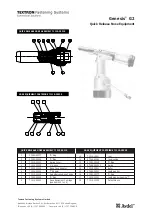
Recommended
1. Branch pipe
2. Main pipe approx. 1:100 Downward pitch away from the compressor
3. Drain trap
4. Shut-off valve
5. Filter
6. Regulator
7. Oiler
8. Coupling
9. Air Hose (thick as poss)
10. Air compressor
11. Main pipe
Technical specifications
Before taking into use
Read and understand the contents of this manual before installing, operating, repairing, maintaining, changing accessories this tool.
Only qualified and trained operators should install, adjust or use the tool.
Please fill some droplets of resin and acid free oil into the air inlet and let the tool run free for a couple of seconds. (E.g. Red Rooster air tool oil: Order
no. Atlub)
Before connecting the hose to the tool please check, whether the hose and the quick coupler are clean. Do this by letting air run freely through hose and
quick coupler, It is absolutely necessary, that quick coupler and hose have a sufficient diameter. Please note, that the hose is never too big, but mostly too
small!
Air pressure at the inlet of the tool during running has to be at the maximum of 6.3 bar. When this pressure is exceeded, unnecessary wear and/or
damage will occur. At the pressure of below 5.5 bar power loss will occur and if the pressure is excessively low, also additional wear/damage will occur.
The quality of the compressed air must be good, which means clean, dry and this is best assured by means of an air filter. We advise the use of a
complete FRL (filter, regulator, lubricator) unit. The oiler has to be adjusted to approx. 3 to 6 droplets per minute. The air hose between oiler and tool
should never exceed a length of 6 to 8 meters.
In those cases, where it is possible, use of a centralized oiler is recommended by us. This system will allow use of less oil and assure a perfect lubrication.
When using a centralized oiler, oil consumption can be reduced by up to 80%.
Do not ignore safety precautions!
Safety
Do not modify this tool in any way, this can cause danger for the operator.
Make sure that this manual is accessible at all times for any relevant person, in case of loss of this manual ask your dealer for a new copy.
Make sure that during operation of the tool no projectiles can be generated, this can be dangerous and may cause injuries.
Make sure that the work piece is securely fixed.
Make sure that no dangerous circumstances can occur for other persons in the work area.
Always wear safety glasses during operation of the tool. The grade of protection must be in relation to the risk of the operation.
The use of safety-/working gloves is recommended.
Use ear protection as instructed by your employer or as required by occupational health and safety requirements.
Reasonable countermeasures have to be taken to keep the noise level as low as possible.
Disconnect the air supply before changing inserted tools, accessories, repairs or when the tool is not being used.


























